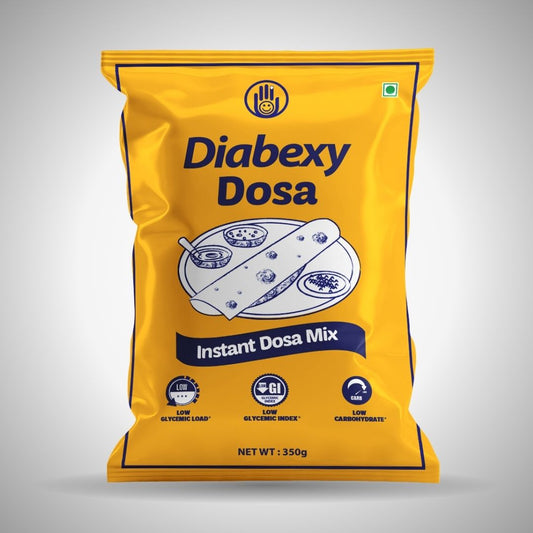Dahi vada is a popular Indian snack or appetizer made with dumplings soaked in yogurt and topped with various spices. These dumplings are called vadas. We made a dahi vada recipe using low glycemic load ingredients, such as Diabexy Dosa mix, because traditional dahi vada is made with gram flour, which has a high glycemic load and is less nutritious than Diabexy Dosa mix.
The taste of dahi vada is creamy, tangy, and mildly spicy. First, the vadas are fried, then gently soaked in water to soften, and finally dipped into chilled yogurt. The result is a dish that’s cool and comforting. It is a traditional Indian dish, specifically from North India, with origins that can be traced back to ancient times. Dahi vada is quite popular across India and is often enjoyed at festivals, weddings, and special occasions, and also served as a snack or appetizer.
Here, we are sharing a healthy, delicious, and easy-to-make dahi vada recipe using low glycemic load ingredients, making it diabetic-friendly. This recipe is perfect for those who prioritize their health without compromising on taste.
Dahi Vada Recipe Ingredients
- 30g Diabexy dosa mix
- Chopped coriander leaves
- Green chili, chopped
- Chopped ginger
- NutroActive mineral salt
- Mustard oil or olive oil (for frying)
- Hot water
- 1-2 tsp Hing (asafoetida)
- 50g curd (yogurt)
- Roasted cumin (jeera) powder
- Roasted coriander powder
- Red chili powder
How to Make Dahi Vada: Step-by-Step Guide with Pictures
- In a mixing bowl, combine 30g Diabexy dosa mix with chopped coriander leaves, green chili, chopped ginger, and NutroActive mineral salt.
-

- Gradually add water to the mixture, stirring until you achieve a batter-like consistency.
-

- Shape the batter into small vadas (dumplings).
- Heat mustard oil or olive oil in a pan and deep-fry the vadas until they turn golden brown.
-

- In a separate bowl, some water and dissolve 1-2 tsp Hing (asafoetida).
-

- Dip the fried vadas into the Hing water and soak them for 10 minutes.
-

- In another bowl, mix 50g curd with chopped coriander and NutroActive mineral salt.
-

- Add the soaked vadas to the curd mixture.
-

- Sprinkle with roasted cumin powder, roasted coriander powder, and red chili powder.
-

- Garnish with additional chopped coriander and chopped ginger.
-

- The glycemic load of dahi pakoda is 3.
Typically, dahi vada is made with gram flour, which has a high glycemic load and less nutritious value than Diabexy Dosa mix. So we use Diabexy Dosa mix which has a lower glycemic load, this recipe is more diabetic-friendly.
The recipe is still delicious, creamy, and tangy like traditional dahi vada. The vadas are made from a batter that's fried and then soaked in a mixture of Hing (asafoetida) and water before being combined with chilled yogurt. The yogurt adds a cooling touch, while the spices like roasted cumin and coriander powder enhance the flavor.
By opting for mustard or olive oil for frying and using low-glycemic ingredients, you’re making a healthier choice. The dish remains rich in flavor and texture, making it best for diabetic patients, it's perfect for special occasions or as a special treat without compromising your health.



